Class 7 Civics Chapter 8 Notes - A Shirt in the Market
Introduction
Imagine walking into a bustling market, where the air is filled with the sounds of people bargaining, the smell of fresh fruits, and the sight of colorful stalls. Markets are lively places where people come together to buy and sell goods.
Whether it's fresh vegetables, clothes, or toys, markets are full of energy and excitement. Today, we'll explore what makes markets so special, how they work, and why they are important in our daily lives!
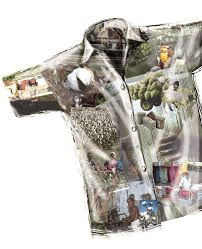
A Cotton Farmer in Kurnool
- Swapna is a small farmer in Kurnool, Andhra Pradesh. She grows cotton on her small piece of land.
- Swapna and her husband pick the ripe cotton bolls. Instead of selling at the Kurnool cotton market, they take it to a local trader.
- Swapna had borrowed Rs 2,500 from the trader at a high-interest rate for cultivation. She promised to sell all her cotton to the trader.
- At the trader's yard, the cotton is weighed, fetching Rs 6,000 at Rs 1,500 per quintal. The trader deducts Rs 3,000 for loan repayment and interest. Swapna receives only Rs 3,000 for her hard work.
- Swapna knows the cotton could sell for more but doesn't argue. The trader is powerful in the village, and farmers depend on him for loans.
- Swapna's earnings from cotton are barely more than what she might have earned as a wage laborer. Small farmers like Swapna face challenges and often need to borrow money for various needs.
- This situation highlights the vulnerability of small farmers, the power dynamics with local traders, and the financial struggles they face in the agricultural process.
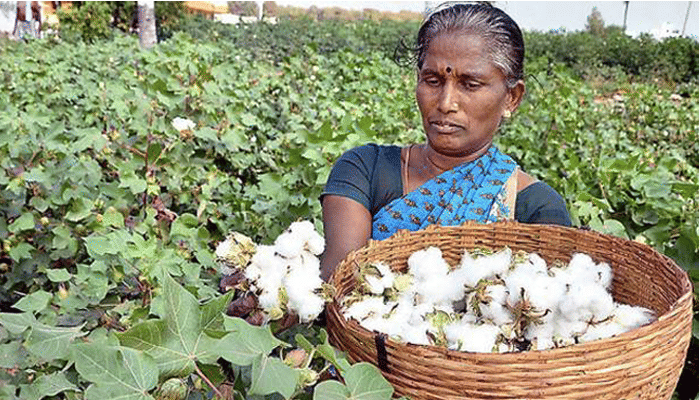 Cotton farmer in Kurnool
Cotton farmer in Kurnool
The Cloth Market of Erode
- Erode's cloth market in Tamil Nadu is one of the world's largest.
- The market offers a wide variety of clothes, including products made by local weavers.
- Cloth merchants' offices surround the market, buying cloth from weavers in nearby villages.
- Traders from various South Indian towns also visit this market to purchase clothes.
- Weavers bring custom-made cloth on market days as per orders from merchants.
- Merchants play a crucial role in the supply chain by providing cloth on order to garment manufacturers and exporters.
- They buy yarn and instruct weavers on the type of cloth needed.
- This system helps connect local weavers to a broader market and ensures a consistent supply of cloth for manufacturers and exporters.
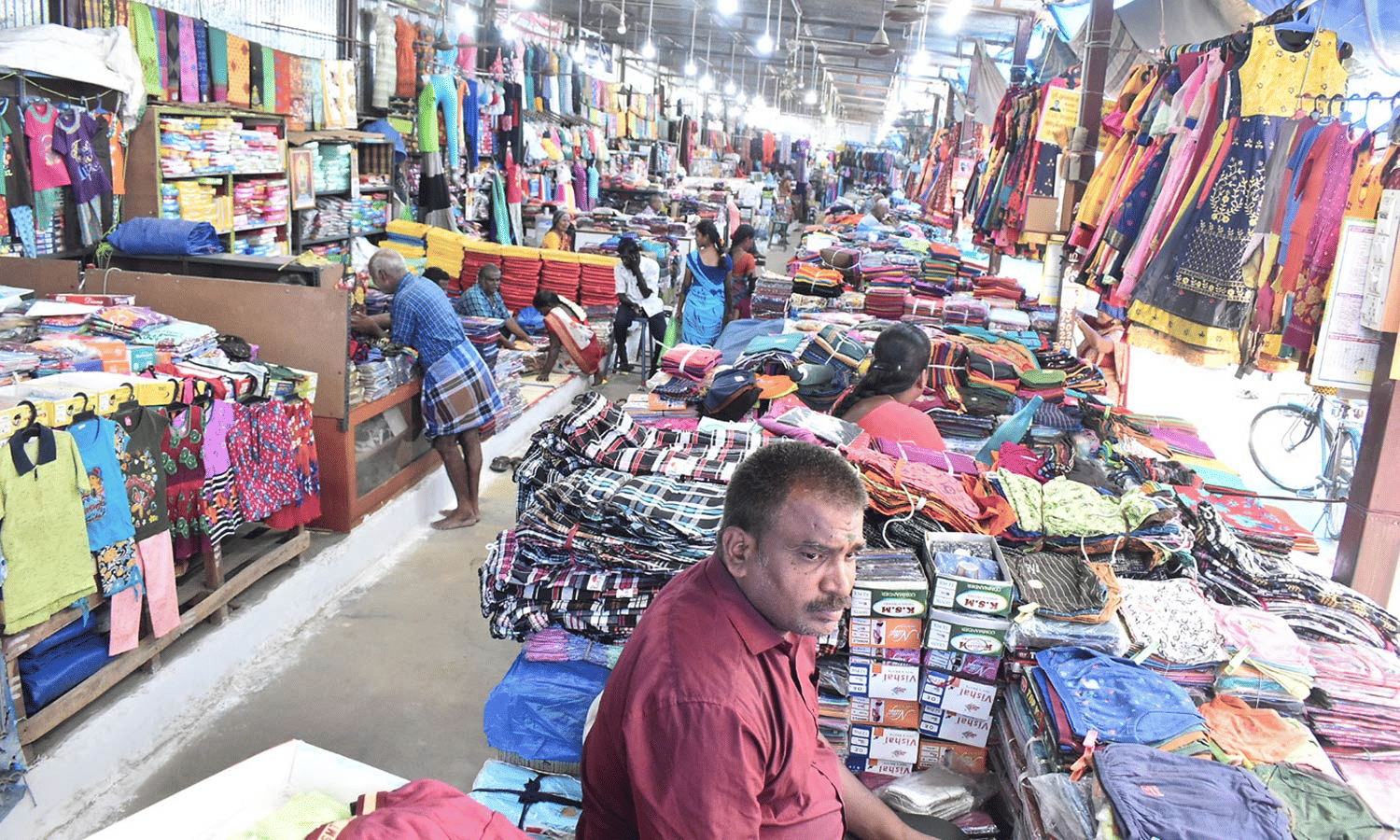 Cloth Market of Erode
Cloth Market of Erode
Putting-out system– weavers producing cloth at home
(i) Merchant-Weaver Relationship: The merchant decides what cloth the weavers make based on received orders. Weavers receive yarn from the merchant and provide the finished cloth.
(ii) Advantages for Weavers: Weavers don't spend money on buying yarn. They know in advance what cloth to make, and selling the cloth is taken care of.
(iii) Dependence and Power Imbalance: Weavers depend on merchants for raw materials and markets. Merchants have significant power as they give orders and pay low prices for the cloth.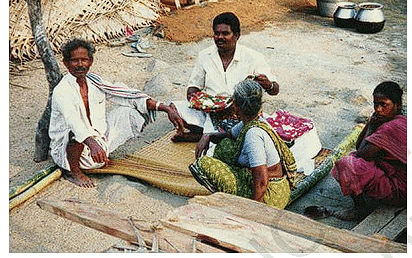 Weavers Producing Cloth
Weavers Producing Cloth
(iv) Market Dynamics: Merchants sell the cloth to garment factories at the cloth market. The market tends to favor the merchants in this arrangement.
(v) Weavers' Challenges: Weavers invest their savings or borrow money at high-interest rates for looms (Rs 20,000 each). Small weavers with two looms invest Rs 40,000. They work up to 12 hours a day, earning about Rs 3,500 per month.
(vi) Putting-Out System: This arrangement is an example of the putting-out system. The merchant supplies raw materials and receives the finished product. Common in the weaving industry across many regions of India.

The garment exporting factory near Delhi
The Erode merchant supplies cotton cloth made by weavers to a garment exporting factory near Delhi. The garment exporting factory uses the cloth to make shirts.
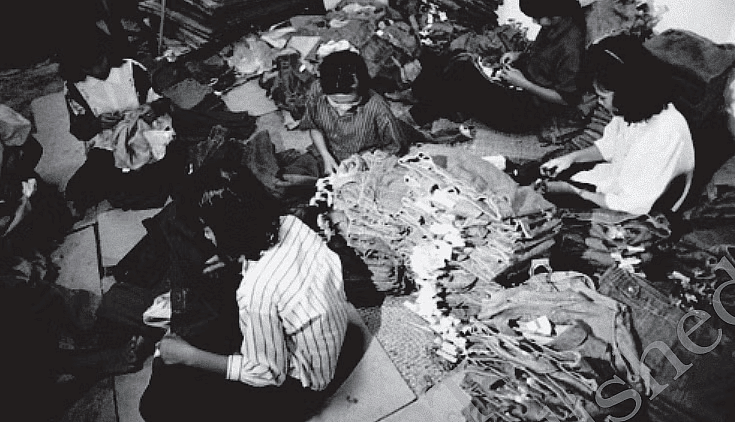 Garment Exporting Factory
Garment Exporting Factory
- Export to Foreign Buyers: Shirts are exported to foreign buyers, including businesspersons from the US and Europe who run chain stores.
- Challenges from Powerful Buyers: Foreign buyers demand the lowest prices, high production quality, and timely delivery. Any defects or delays are strictly dealt with by the buyers.
- Pressure on Garment Exporting Factories: To meet buyer conditions, factories try to cut costs. This often means maximizing work from workers at the lowest wages.
- Impex Garment Factory: Employs 70 workers, mostly women. Many workers are on a temporary basis, making them vulnerable to being asked to leave when not needed.
- Wage Structure: Wages are based on skills, with tailors being the highest paid at about Rs 3,000 per month. Women are employed for tasks like thread cutting, buttoning, ironing, and packaging, which have the lowest wages.
This system emphasizes the challenges faced by workers, especially women, in garment factories that export to foreign markets. The pressure to cut costs often results in temporary employment and lower wages for workers.
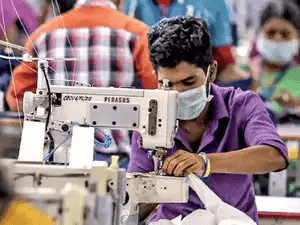
The Shirt in the US
(i) Businessperson in the United States
Imagine someone buys shirts from a place called Delhi and sells them in the United States. They sell each shirt for $26 but they have to spend money to get the shirts, advertise them, and handle other costs. The total of all these costs per shirt is $900.
Now, let's figure out how much they bought each shirt for from Delhi.
Cost Price per shirt = Selling Price − Total Cost
Cost Price per shirt=26−900=−874
It seems something might be off here because we're getting a negative number. But if we continue with this, it means the person is losing money instead of making a profit. Let's move on to the exporter.
(ii) Garment Exporter in Delhi
The exporter in Delhi sells shirts to the person in the US. They sell each shirt for ₹300. But they have their own costs too, like buying materials, paying workers, and running their office. Let's add up those costs:
Total Cost per shirt = Cost of Materials+ Worker Wages+ Office Running Cost
Total Cost per shirt = ₹ 100 + ₹25 + ₹25 = ₹150
Now, let's find out how much profit the exporter makes on each shirt:
Profit per shirt = Selling Price − Total Cost
Profit per shirt = ₹300 − ₹ 150 = ₹150
So, the exporter makes ₹150 profit on each shirt they sell to the person in the US.
Who are the gainers in the market?
- Within the market chain connecting cotton producers to supermarket shoppers, transactions occur at various stages.
- Reflecting on the participants in these transactions, it's evident that not everyone benefited equally.
- While some individuals profited from market activities, others, despite their considerable effort, saw limited returns.
Market and Equality
- In the market, some people make big profits, like foreign businesspeople, while others, like garment exporters, make less. But workers in garment factories barely earn enough to get by.
- Even small cotton farmers and weavers work hard but don't get fair prices for what they sell. Merchants make more money than weavers but still less than exporters.
- So, not everyone benefits equally from the market. Democracy means everyone should earn a fair wage. The market provides opportunities for work and selling goods, but usually, the rich and powerful earn the most.
- The poor often rely on the rich for loans, materials, and jobs, making them vulnerable to exploitation. To overcome this, people can form producer cooperatives and ensure that laws are followed closely.
Glossary:
(i) Ginning mill: A ginning mill is where cotton is processed to remove seeds from the fibers. This process is essential for preparing cotton to be spun into thread and woven into fabric, playing a key role in the textile industry.
(ii) Exporter: An exporter is a person or company that sells goods or services to other countries. They help businesses reach international markets and play a crucial role in global trade.
(iii) Profit: Profit is the money a business earns after subtracting all its costs and expenses. It's the reward for successfully running a business and is essential for growth and sustainability.
|
63 videos|552 docs|46 tests
|
FAQs on Class 7 Civics Chapter 8 Notes - A Shirt in the Market
| 1. What is the significance of cotton farming in Kurnool? |  |
| 2. How does the cloth market in Erode contribute to the local economy? |  |
| 3. What is the putting-out system, and how does it affect weavers? |  |
| 4. What role do garment exporting factories near Delhi play in the global textile market? |  |
| 5. How does the price of a shirt in the US reflect the global supply chain? |  |

















